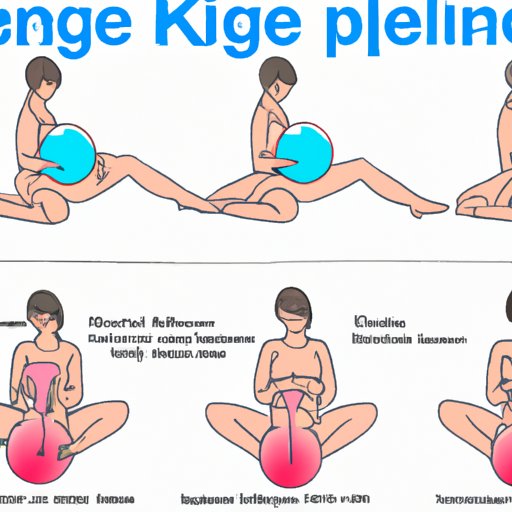Introduction
Kegel exercises are a series of exercises designed to strengthen the muscles of the pelvic floor. These exercises can be beneficial for both men and women, but they are particularly helpful for women because they can help improve bladder control, reduce the risk of urinary incontinence, and even improve sexual satisfaction. In this article, we’ll take a closer look at what Kegel exercises are, the benefits they offer, and how to do them correctly.
A Comprehensive Guide to Kegel Exercises for Women
What are Kegel Exercises for Women?
Kegel exercises were first developed in 1948 by Dr. Arnold Kegel. He believed that strengthening the pelvic floor muscles could help improve bladder control and prevent urinary incontinence. Today, Kegel exercises are widely used by women to improve their overall pelvic health and well-being.
The pelvic floor muscles are the muscles located between your legs, extending from your pubic bone to your tailbone. They support the organs in your pelvis, including the bladder, uterus, and rectum. When these muscles become weak or too tight, it can lead to a variety of issues, such as urinary incontinence, pelvic organ prolapse, and painful intercourse.
Kegel exercises involve contracting and relaxing the pelvic floor muscles. This helps to strengthen the muscles, increase blood flow to the area, and ultimately improve your overall pelvic health.
Benefits of Kegel Exercises for Women
Kegel exercises can offer a number of benefits for women, including improved bladder control, decreased pelvic pain, and enhanced sexual satisfaction. According to a study published in the Journal of Physical Therapy Science, “Kegel exercises are effective in improving urinary incontinence, pelvic organ prolapse symptoms, and sexual function in women.”
Kegel exercises can also help pregnant women prepare for childbirth. Strengthening the pelvic floor muscles can help make labor and delivery easier and less painful. Additionally, after childbirth, Kegel exercises can help speed up the healing process and reduce the risk of urinary incontinence.

How to Do Kegel Exercises for Women
Step-by-Step Instructions
To do Kegel exercises correctly, follow these steps:
- Sit or lie down in a comfortable position.
- Contract the muscles of your pelvic floor. To do this, imagine you are trying to stop the flow of urine or prevent yourself from passing gas.
- Hold the contraction for 3-5 seconds, then relax for 3-5 seconds.
- Repeat 10 times.
It’s important to note that you should not hold your breath while doing Kegel exercises. Instead, focus on breathing normally throughout the exercise.
Tips for Doing Kegel Exercises Properly
When performing Kegel exercises, it’s important to make sure you are doing them properly. Here are some tips to keep in mind:
- Focus on tightening only your pelvic floor muscles. Don’t tense your stomach, buttocks, or thighs.
- Start with shorter holds and fewer repetitions. As you get stronger, you can increase the duration and number of repetitions.
- Practice your Kegel exercises regularly. Aim to do them at least 3 times a week.
- Be patient. It may take several weeks for you to notice any changes.

Common Mistakes to Avoid When Doing Kegel Exercises for Women
Although Kegel exercises are relatively simple, there are still some common mistakes that women make when doing them. Here are some of the most common mistakes to avoid:
Not Performing the Exercises Regularly
Kegel exercises are like any other form of exercise – if you don’t do them regularly, you won’t see results. Make sure to do your Kegel exercises at least 3 times per week to ensure you are getting the full benefits of the exercises.
Doing Too Many Repetitions
It’s important to start slow and gradually build up the number of repetitions you do. Doing too many repetitions can actually cause more harm than good. Start with 10 repetitions and work your way up from there.
Not Relaxing the Muscles After Each Exercise
It’s important to relax the pelvic floor muscles after each exercise. If you don’t take time to relax your muscles, it can lead to tension and overworking the muscles, which can have a negative effect on your pelvic health.

Different Types of Kegel Exercises for Women
There are three main types of Kegel exercises: concentric, eccentric, and isometric. Let’s take a closer look at each one.
Concentric Kegels
Concentric Kegels involve contracting the pelvic floor muscles and holding the contraction for a few seconds before releasing. This type of exercise is great for beginners, as it helps to strengthen the muscles and increase blood flow to the area.
Eccentric Kegels
Eccentric Kegels involve contracting the pelvic floor muscles and then slowly releasing the contraction. This type of exercise helps to lengthen the muscles, which can improve flexibility and range of motion.
Isometric Kegels
Isometric Kegels involve contracting the pelvic floor muscles without moving them. This type of exercise is more advanced and can help to improve muscle coordination and strength.
Conclusion
Kegel exercises are a great way to improve your pelvic health and well-being. They can help strengthen the pelvic floor muscles, improve bladder control, reduce pelvic pain, and enhance sexual satisfaction. By following the steps outlined above, you can ensure that you are doing your Kegel exercises correctly and getting the most out of them.
Summary of Benefits of Kegel Exercises for Women
Kegel exercises can offer a number of benefits for women, including improved bladder control, decreased pelvic pain, and enhanced sexual satisfaction. Additionally, they can help pregnant women prepare for childbirth and aid in the postpartum healing process.
Final Thoughts on Kegel Exercises for Women
Kegel exercises are an excellent way to improve your overall pelvic health. However, it’s important to remember that these exercises can take time and practice to master.
(Note: Is this article not meeting your expectations? Do you have knowledge or insights to share? Unlock new opportunities and expand your reach by joining our authors team. Click Registration to join us and share your expertise with our readers.)
